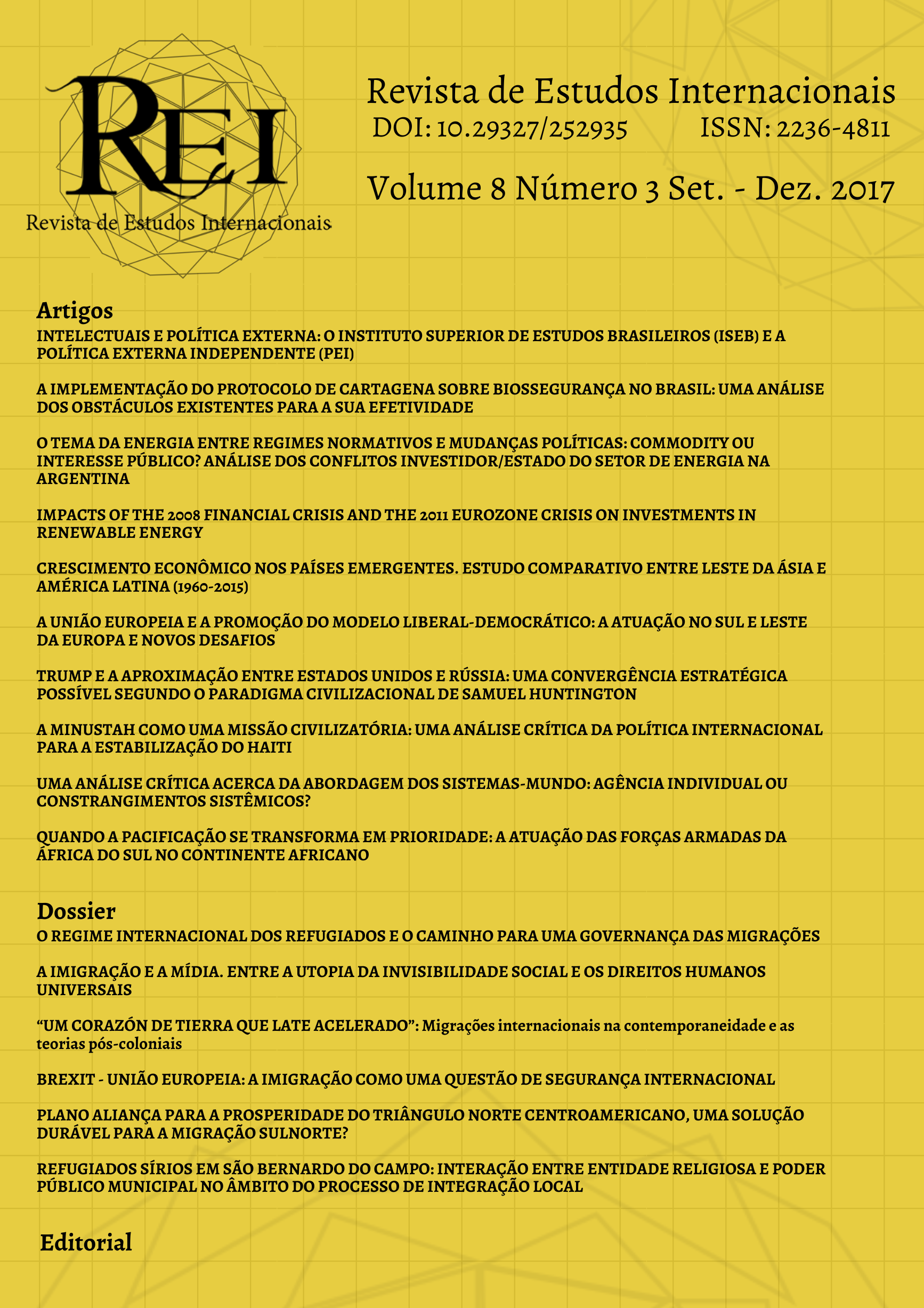CRESCIMENTO ECONÔMICO NOS PAÍSES EMERGENTES. ESTUDO COMPARATIVO ENTRE LESTE DA ÁSIA E AMÉRICA LATINA (1960-2015)
Palavras-chave:
Crescimento econômico, Convergência econômica, Investimento estrangeiro direto, Leste da Ásia, América LatinaResumo
Nesta investigação nos propusemos a comparar o crescimento econômico entre a Ásia e a América Latina durante o período 1960 - 2015. A metodologia é baseada em duas técnicas, uma análise exploratória de dados (AED) e testes econométricos de análise de regressão de séries temporais em um modelo de regressão simples, através da obtenção de estimativas por mínimos quadrados ordinários (MQO). Conclui-se que a variável mais significativa para entender a divergência do crescimento econômico nas regiões do leste da Ásia e na América Latina é o investimento direto estrangeiro (IDE).
Referências
AGHION, Philippe; HOWITTt, Peter(1992).A model of growth through creative
destruction. Econometrica, 60 (2): 323-351.
______. (1998). Endogenous Growth Theory, Cambridge, Massachusetts: The MIT
Press.
BARRO, Robert; SALA-I-MARTIN, Xavier (1992). Convergence. Journal of Political
Economy, 100 (2): 223-251.
______. (2004). Economic Growth. Nueva York, Estados Unidos: Mc Graw-Hill.
DORNBUSCH, Rudiger; FISCHER, Stanley y STARTZ, Richard (2009).
Macroeconomía. Mexico: Mc Graw Hill.
HEYMANN, Daniel (2000). Grandes perturbaciones macroeconómicas, expectativas y
respuestas de política. Revista de la CEPAL, 70: 13-29
JONES, Charles. (2015).The Facts of Economic Growth. National Bureau of Economic
Research. Series, 21142: 1-85
KAWAI, Haroki. (1994). International comparative analysis of economic growth: trade
liberalization and productivity. The Developings Economies 32 (4): 373-398.
KRUEGER, Anne (1995). East Asian Experience and Endogenous Growth Theory. In:
TAKATOSHI, Ito & KRUEGER, Anne O. (eds). Growth Theory in Light of the Easy
Asian Experience, Chicago: Chicago University Press, 9-36.
LUCAS, Robert (1988). On the mechanics of economic development. Journal of
Monetary Economics, 22, (1): 3-42.
NAOKO, Munakata (2006). Transforming the East Asia: the evolution of regional
economic integration. Washington: Brookings Institution Press.
OCAMPO, José (2005). La búsqueda de la eficiencia dinámica. In OCAMPO, José (ed.).
Más allá de las reformas. Washington: CEPAL.
______. (2011). Macroeconomía para el desarrollo: políticas anticíclicas y transformación
productiva. Revista de la CEPAL, 104: 7 – 36.
PAGE, John (1994). The East Asian Miracle: Four Lessons for Development Policy.
National Bureau of Economic Research. Macroeconomics Annual 1994, 219-282.
QUANTITATIVE MICRO SOFTWARE (2007). [Software] Eview: Microsoft Windows.
RADELETt, Steven; SACHS, Jeffrey (1997).Reemerging Asia. Foreign Affairs, 76 (6):
-59.
RODRIK, Dani (2003). Growth Strategies. National Bureau of Economic Research.
: 1-60.
ROMER, Paul (1990). Endogenous technical change. Journal of Political Economy, 98
(5): 71-102.
______. (1993). Idea Gaps and Object Gaps in Economic Development.Washington:
Banco Mundial.
ROS, Jaime (2000), Development Theory and the Economics of Growth. Michigan: The
University of Michigan Press.
______. (2005). Divergencia y colapsos del crecimiento: teoría y evidencia empírica. In,
OCAMPO, José (ed..) Más allá de las reformas. Washington: CEPAL
SOLOW, Robert.(1956): A contribution to the theory of economic growth. Quarterly
Journal of Economics, 70 (1): 65-94.
______. (1957). Technical change and aggregate production function. Review of
Economic Statistics, 39 (3): 312-320.
STIGLITZ, Joseph. (2001). Development Thinking at the Millenium. In BANCO
MUNDIAL (ed.). Annual World Bank Conference on Development Economics 2000,
– 38.
______. (2003). El rumbo de las reformas. Hacia una nueva agenda para América Latina.
Revista de la CEPAL, 80: 7-40.
YOUNG, Alwyn (1994). The Tyranny of Numbers: Confronting the Statistical Realities of
the East Asian Growth Experience. NBER Working Paper Series, 110 (agosto): 641-680.


